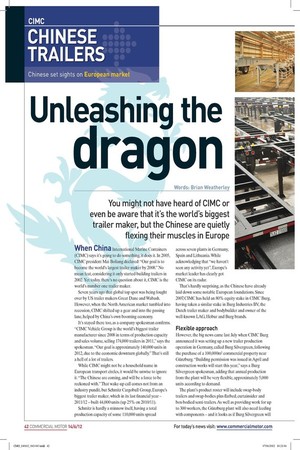Unleashing the
Page 33

Page 34

If you've noticed an error in this article please click here to report it so we can fix it.
ragon
Words: Brian Weatherley
You might not have heard of CIMC or even be aware that it’s the world’s biggest trailer maker, but the Chinese are quietly flexing their muscles in Europe
When China International Marine Containers (CIMC) says it’s going to do something, it does it. In 2005, CIMC president Mai Boliang declared: “Our goal is to become the world’s largest trailer maker by 2008.” No mean feat, considering it only started building trailers in 2002. Yet today, there’s no question about it, CIMC is the world’s number one trailer maker.
Seven years ago that global top spot was being fought over by US trailer makers Great Dane and Wabash. However, when the North American market tumbled into recession, CIMC shifted up a gear and into the passing lane, helped by China’s own booming economy.
It’s stayed there too, as a company spokesman confirms. “CIMC Vehicle Group is the world’s biggest trailer manufacturer since 2008 in terms of production capacity and sales volume, selling 174,000 trailers in 2011,” says the spokesman. “Our goal is approximately 140,000 units in 2012, due to the economic downturn globally.” That’s still a hell of a lot of trailers.
While CIMC might not be a household name in European transport circles, it would be unwise to ignore it. “The Chinese are coming, and will be a force to be reckoned with.” That wake-up call comes not from an industry pundit, but Schmitz Cargobull Group, Europe’s biggest trailer maker, which in its last financial year – 2011/12 – built 44,000 units (up 25% on 2010/11).
Schmitz is hardly a minnow itself, having a total production capacity of some 110,000 units spread across seven plants in Germany, Spain and Lithuania. While acknowledging that “we haven’t seen any activity yet”, Europe’s market leader has clearly got CIMC on its radar.
That’s hardly surprising, as the Chinese have already laid down some notable European foundations. Since 2007, CIMC has held an 80% equity stake in CIMC Burg, having taken a similar stake in Burg Industries BV, the Dutch trailer maker and bodybuilder and owner of the well-known LAG, Hobur and Burg brands.
Flexible approach
However, the big news came last July when CIMC Burg announced it was setting up a new trailer production operation in Germany, called Burg Silvergreen, following the purchase of a 100,000m2 commercial property near Günzburg. “Building permission was issued in April and construction works will start this year,” says a Burg Silvergreen spokesman, adding that annual production from the plant will be very flexible, approximately 5,000 units according to demand.
The plant’s product roster will include swap-body trailers and swap-bodies plus flatbed, curtainsider and box-bodied semi-trailers. As well as providing work for up to 300 workers, the Günzburg plant will also need feeding with components – and it looks as if Burg Silvergreen will be leveraging the power of CIMC by sourcing some of them from China. Burg Silvergreen’s spokesman confirms: “Some components with low-complexity and with little-or-no relevance to customer requirements can be produced cheaper in large quantities, at high-quality, in China and usually require little transportation space.” He adds that those Chinese components will be produced according to German quality standards, while all major components, including axles or brakes, will be sourced from European manufacturers.
So what can we expect from CIMC in the short term and is there room in the European market for such a big player? Seasoned trailer industry watcher and commentator Gary Beecroft of Clear Consulting notes: “While Europe is a big trailer market – over 300,000 units were produced in 2007/8 – despite those volumes you need a decent distribution network and after-sales service.” He adds: “The market can be divided into two clear categories. At one end there’s curtainsiders and container chassis, which are low-cost and high-volume and the expensive end of the market with refrigerated trailers where volumes are lower but where you do better on price. It depends where you want to go. Given their capacity, I’d think the volume market would be more attractive to CIMC.” Interestingly, CIMC says: “We have been selling Chinese-built curtainsider trailers in Europe since 2011, to major logistics companies via LAG.” A re-emerging European trailer market, especially in the east, could also provide CIMC with the incentive to ‘go for it’, although Beecroft cautions: “The western and eastern European trailer markets are quite different. The western market is a mature one where the total size of the trailer fleet won’t grow very far in the future. We’re already at a level where the number of trailers in the [western European] market can probably satisfy the demands for transport – whereas in the east, particularly in some countries like Russia, there’s still strong demand for new trailers annually, and it’s a lot easier to grow sales in a growing market. There’s still a lot of competition with local manufacturers. However, there are good opportunities there.” Whatever CIMC’s goal is for Europe, CM will certainly be watching the Chinese dragon with great interest, especially in September when Burg Silvergreen makes its IAA Hanover Show debut. ■










































